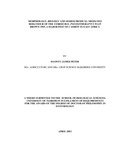| dc.description.abstract | The coreid bug, Pseudotheraptus wayi Brown 1955 (Heteroptera: Coreidae), is a
major pest of cashew in East Africa. Effective environmentally sound management
strategies for this pest are still lacking. This study aimed at elucidating the chemical
communication system of P. wayi and, identifying semiochemicals that can
potentially be developed into lures for use in integrated management of this pest. To
achieve this, pre-requisite studies on the morphology of immatures to facilitate
effective identification of this pest in the field, evaluation of French bean pods for
suitability for mass rearing of the insects and diel behavioural patterns of the species
to guide semiochemical bioassays were also carried out. Morphometric
measurements were carried out using a Leica® Microsystems EZ4D microscope
connected to a computer using the recommended Leica® Application Suite
Software. The suitability of French beans for mass rearing of P. wayi and its diel
behavioural patterns were determined by observation of the biology and behaviour of
the insects on French bean pods in the laboratory. Candidate semiochemicals were
identified by olfactometry, EthoVision XT digital video recording of insect
behaviour, gas chromatography-electroantennographic detection and gas
chromatography-mass spectrometry. The study has shown that immatures of this pest
have unique morphological features, the knowledge of which can facilitate effective
identification of the insects in the field. It has also demonstrated that French beans
are more suitable for mass rearing of this species than coconut and cashew which
have been used previously but were unavailable in Nairobi, Kenya where this study
was carried out, and can be scarce and too costly. In addition, the study has revealed
that peak mating in this species occurs at mid scotophase, and more mating
incidences take place during scotophase than photophase; peak oviposition occurs at
late photophase with another minor peak at late scotophase, and more eggs are laid
during photophase than scotophase; peak nymphal feeding occurs between 18:00 and
0:00 hours, with more nymphs feeding during scotophase than photophase; and adult
feeding pattern is unaffected by time or light and darkness. This knowledge was
useful for proper timing of behavioural bioassays, and may also be applied in proper
timing of control interv~ntions in the field. Finally and most importantly, three
chemicals namely (Z)-fi-ocimene, (E)-fi-ocimene and allo-ocimene were identified
from cashew volatiles as attractants for male P. wayi; while hexanal, hexyl acetate
and hexyl hexanoate in the natural ratio as in male volatiles facilitate recognition of
males by either sex, eliciting attraction in females but repellence in males. These
candidate semiochemicals offer opportunities for trapping P. wayi in the field. | en |

